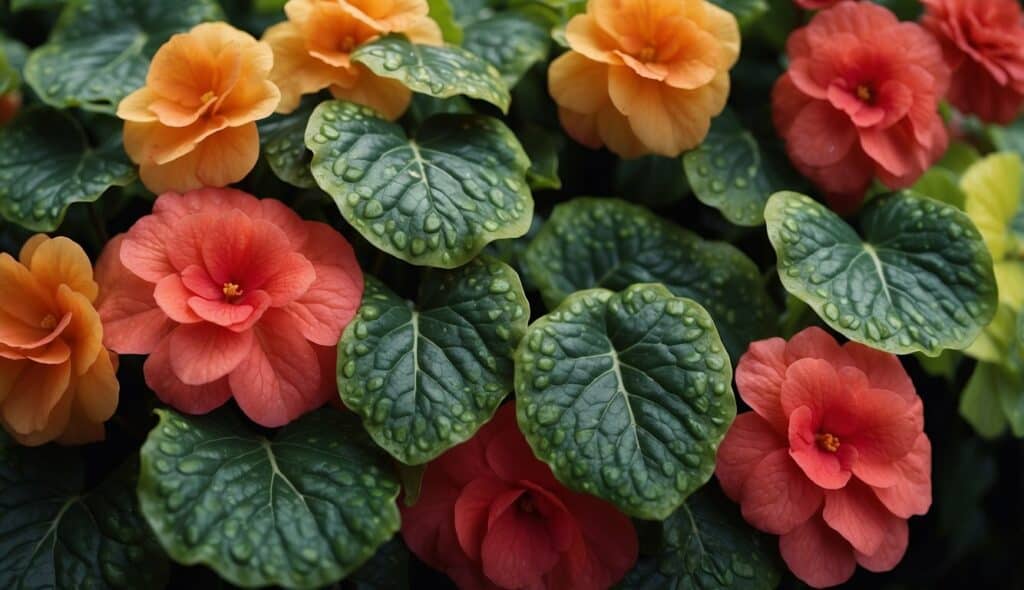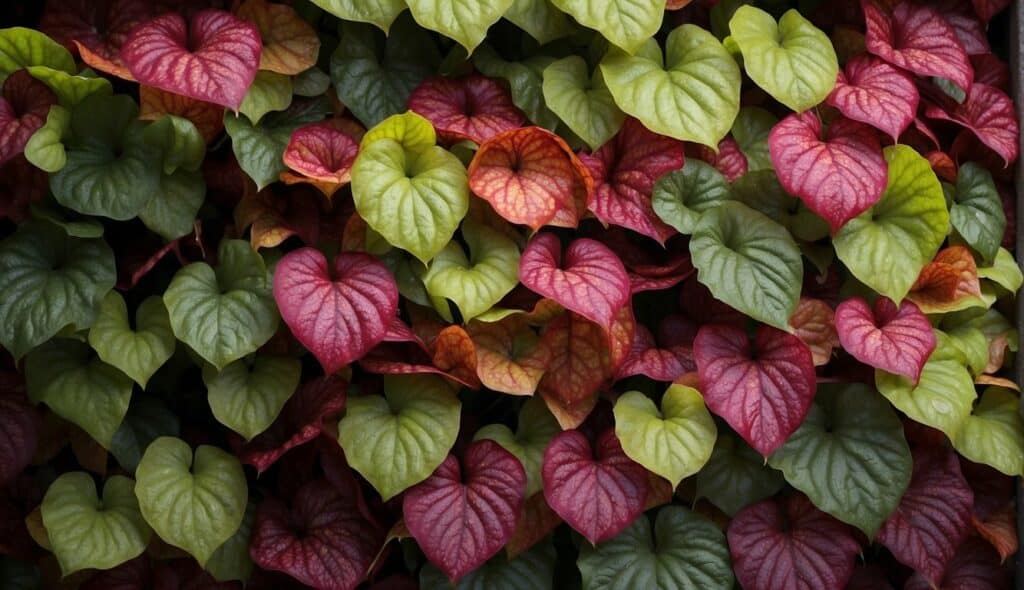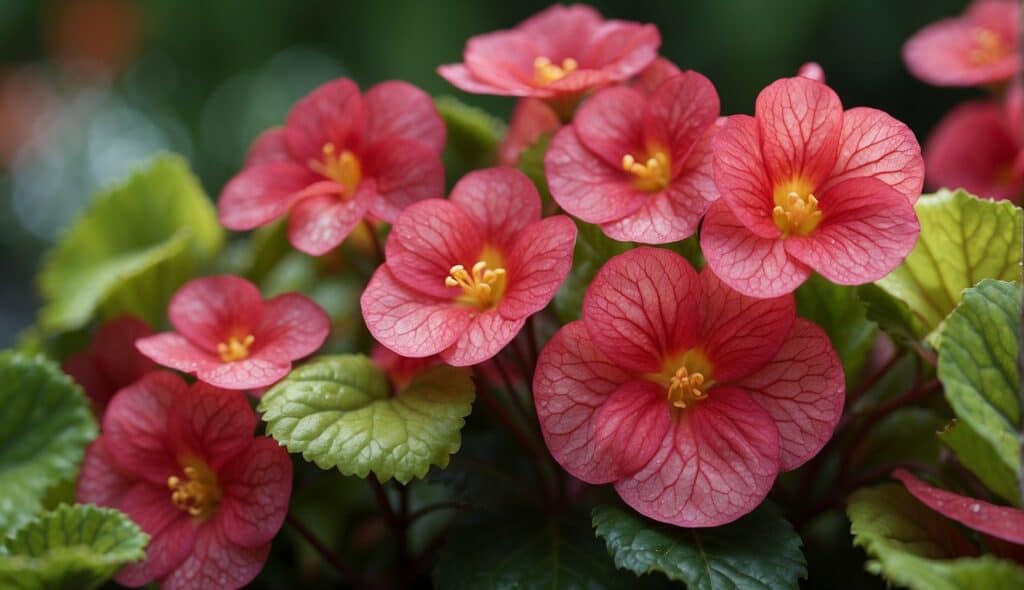Begonia Rex-Cultorum, commonly known as Rex Begonia, is a popular houseplant known for its stunning foliage.
The leaves of this plant come in a wide range of colors and patterns, making it a popular choice for those who want to add a touch of color to their indoor spaces.
Rex Begonia is a cultivar of the Begonia plant, which is native to tropical and subtropical regions.

The unique foliage of Rex Begonia is what makes it stand out from other houseplants.
The leaves are large and asymmetrical, with a velvety texture that adds to their appeal.
The colors of the leaves range from deep greens to bright pinks and purples, with intricate patterns that resemble tapestries.
This makes it a popular choice for those who want to add a touch of elegance to their homes.
In this article, we will explore the world of Rex Begonia and delve into the tapestry of colors and patterns that make this plant so unique.
From its origins to its care and maintenance, we will cover everything you need to know about this stunning houseplant.
Whether you are a seasoned plant enthusiast or a beginner looking to add some greenery to your home, this article is for you.
History of Rex Begonia

Origins and Discovery
Rex Begonia, also known as Begonia Rex-Cultorum, is a species of flowering plant that belongs to the Begoniaceae family.
It is native to the tropical regions of India, China, and Southeast Asia.
The plant was first discovered in 1856 by a French botanist, Charles Plumier, during his expedition to the Caribbean islands.
However, it was not until the late 19th century that the plant gained popularity as a houseplant.
Evolution of Cultivars
Over the years, breeders have developed numerous cultivars of Rex Begonia, each with its unique characteristics.
The cultivars are distinguished by their leaf colors, patterns, and shapes.
The leaves of Rex Begonia are known for their intricate patterns that resemble tapestries.
The evolution of cultivars has led to the creation of various types of Rex Begonia, such as the Escargot, Iron Cross, and Silver Satin.
The cultivation of Rex Begonia is a delicate process that requires a lot of care and attention.
The plant thrives in a humid environment and requires well-drained soil.
It is also sensitive to temperature changes, and extreme temperatures can cause damage to the plant.
In conclusion, the history of Rex Begonia is a fascinating one that spans over a century.
The plant’s intricate patterns and unique characteristics have made it a popular choice among gardeners and houseplant enthusiasts alike.
With proper care and attention, Rex Begonia can thrive and bring beauty to any indoor space.
Cultivation Techniques

Soil Requirements
Rex Begonia plants require well-draining soil that is rich in organic matter.
A mixture of peat moss, perlite, and vermiculite is recommended for optimal growth.
It is important to ensure that the soil is never allowed to dry out completely, as this can cause the leaves to wilt and drop.
Watering Practices
Rex Begonias prefer to be kept consistently moist, but not waterlogged.
It is important to water the plant thoroughly, allowing excess water to drain away, and then allow the soil to dry out slightly before watering again.
Overwatering can lead to root rot, while underwatering can cause the leaves to become dry and brittle.
Light and Temperature
Rex Begonias thrive in bright, indirect light. Direct sunlight can scorch the leaves, while too little light can cause the plant to become leggy and weak.
A temperature range of 60-75°F (15-24°C) is ideal for these plants.
They are sensitive to temperature fluctuations, so avoid placing them near drafts or heating/cooling vents.
Overall, Rex Begonias are relatively easy to care for and make excellent houseplants.
With proper soil, watering, and lighting, these plants can thrive and provide a beautiful tapestry of colors and patterns in any indoor space.
Design and Aesthetics

Leaf Patterns and Colors
Rex Begonias are known for their unique and intricate leaf patterns, making them a popular choice for indoor plants.
The leaves come in a variety of colors, including shades of green, silver, pink, red, and purple.
The patterns on the leaves can range from spirals and swirls to dots and stripes, creating a beautiful tapestry of color and texture.
One of the most striking features of the Rex Begonia is the metallic sheen on its leaves.
This is caused by tiny hairs on the leaves that reflect light, giving the plant a shimmering appearance.
The combination of the metallic sheen and the intricate leaf patterns makes the Rex Begonia a true work of art.
Decorative Uses
The unique design and vibrant colors of the Rex Begonia make it a popular choice for decorative purposes.
It can be used as a centerpiece on a table or as a statement piece in a room.
The plant can also be used to add color and texture to a dull corner of a room.
Rex Begonias are also popular in terrariums and dish gardens.
Their compact size and intricate leaf patterns make them an ideal choice for creating miniature landscapes.
The plant can be paired with other small plants and decorative elements to create a stunning display.
In addition to being used for decorative purposes, the Rex Begonia is also a popular choice for collectors.
With so many different leaf patterns and colors, collectors can spend years searching for the perfect specimen to add to their collection.
Propagation and Care
Propagation Methods
Rex Begonias can be propagated through stem cuttings or leaf cuttings.
Stem cuttings are taken from the tip of a healthy stem and should be around 3-4 inches in length.
Remove the lower leaves and dip the cut end in rooting hormone before planting in a well-draining soil mix.
Keep the soil moist and provide bright, indirect light until new growth appears.
Leaf cuttings can also be taken by selecting a healthy, mature leaf and cutting it into sections with a sharp, clean knife.
Each section should have a main vein and be around 2-3 inches in length.
Place the cuttings on top of a moist soil mix, press down lightly, and cover with plastic to maintain humidity.
New plants should start to emerge within a few weeks.
Common Pests and Diseases
Rex Begonias are generally healthy plants, but they can be susceptible to a few common pests and diseases.
Spider mites and mealybugs can be a problem, especially in dry environments. Regular misting and keeping the soil moist can help prevent infestations.
Fungal diseases such as powdery mildew can be avoided by ensuring good air circulation and avoiding overhead watering.
Maintenance Tips
Rex Begonias prefer bright, indirect light and well-draining soil.
They should be watered when the top inch of soil feels dry to the touch, and fertilized every 4-6 weeks during the growing season.
Avoid overwatering and allow the soil to dry out slightly between waterings to prevent root rot.
Regular pruning can help maintain a bushy, compact shape and promote new growth.
Frequently Asked Questions

How do I properly care for a Rex Begonia plant?
Rex Begonias require well-draining soil and high humidity to thrive. They prefer temperatures between 60-75°F (15-24°C) and should be kept away from drafts.
It’s important to avoid overwatering, as this can lead to root rot. Instead, allow the top inch of soil to dry out before watering thoroughly.
Fertilize with a balanced, water-soluble fertilizer every 4-6 weeks during the growing season.
What are the ideal lighting conditions for Rex Begonia to thrive?
Rex Begonias prefer bright, indirect light. Direct sunlight can scorch their leaves, while too little light can cause the plant to become leggy and weak.
A north-facing window or a shaded spot outdoors can provide the ideal lighting conditions.
Can you give tips on watering and feeding Rex Begonia for optimal growth?
To water Rex Begonias, allow the top inch of soil to dry out before watering thoroughly. Avoid overwatering, as this can lead to root rot.
Fertilize with a balanced, water-soluble fertilizer every 4-6 weeks during the growing season.
What common pests should I watch out for on my Rex Begonia?
Rex Begonias are susceptible to mealybugs, spider mites, and thrips.
Regularly inspect your plant for signs of infestation, such as webbing, small holes in the leaves, or sticky residue.
If you notice any pests, isolate the plant and treat it with an appropriate pesticide or insecticidal soap.
How often should I repot my Rex Begonia, and what soil should I use?
Rex Begonias should be repotted every 1-2 years, or when the plant becomes root-bound.
Use a well-draining potting mix, such as a mixture of peat moss, perlite, and vermiculite.
When repotting, be careful not to damage the plant’s delicate roots.
What are some ways to propagate Rex Begonia to grow my collection?
Rex Begonias can be propagated through leaf cuttings or stem cuttings.
To propagate with leaf cuttings, remove a healthy leaf from the plant and place it in a container of moist soil or water.
After a few weeks, roots and new growth should appear.
To propagate with stem cuttings, cut a healthy stem with several leaves and place it in a container of moist soil or water.
After a few weeks, new growth should appear.














